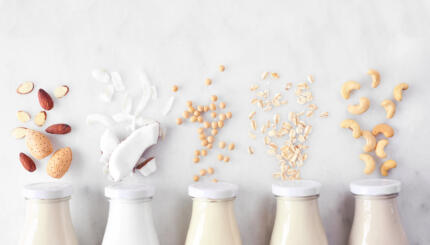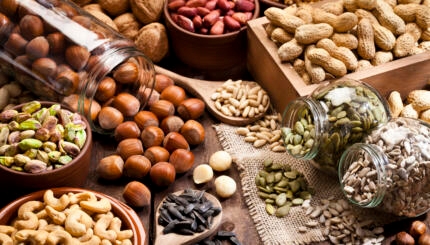Red Quinoa Dessert Pudding
An old grain from the New World.
You might have heard rumors that there's a grain-like food that's for Passover. Better than a new flavor of matzah, quinoa (pronounced keen-wha) is a seed that resembles and tastes like a grain, and can be found at your local grocery store.
While it's a relative newcomer to the American kitchen, having only been introduced to the States in the past 20 years, this ancient Andean seed has been an important food in South America for over 6000 years. A member of the goosefoot family, which is also the family of beets, swiss chard, lamb's quarters, spinach, and amaranth, quinoa is not technically a grain, but can be used as one in cooking.Year-round, quinoa is perfect for vegans, those with celiac, and anyone looking for a change from rice. It's gluten-free and contains all of the essential amino acids, making it a complete protein.
Furthermore, because quinoa grows in the high altitude of the Andes, where
does not grow, there is no chance of cross-contamination with the grains on the do-not-eat list. As long as quinoa is processed in a factory that does not also process grains, it's kosher for Passover and ready for your holiday table. Some approved certifications include the Half-Moon K (KOAOA), found on the Trader Joe's and Ancient Harvest brands of quinoa.
While there is no religious precedent against eating quinoa, there are still those that forbid it. For example, the Vaad Hakashrus of the Eida HaCharedis, a Jerusalem-based ultra-Orthodox organization opposes quinoa on Passover because they believe it is included in the kitniyot prohibition. They also express concern over the potential for cross contamination with any prohibited grains. But the companies mentioned above assure that this is not a problem, and the majority of the kosher-keeping community seems to be embracing this wholesome and satisfying Andean treat for their week without wheat.
Quinoa cooks up very easily, and is far more forgiving than rice. Each individual quinoa seed has bitter saponin covering it, to naturally repel birds and insects while the seed grows. In order to remove the bitter residue you need to wash your quinoa carefully. Simply place the quinoa in a bowl or pot, cover with water, and swish. The water will appear soapy in the bowl due to the saponoin. Pour out through a fine mesh strainer, and repeat the washing until the water runs clear. Many companies selling quinoa in the United States pre-wash their quinoa, but the box will let you know for certain if washing is necessary.
Quinoa is extremely versatile. It can be used in soups, salads, in place of rice for an entree, or even in desserts. Quinoa comes in various colors, including the most common white, but also red, green, and black. It cooks in less than 15 minutes and it's easy to tell when it's done because the seeds display a little white thread that curls around them.
Ingredients
2 teaspoons vanilla extract
1/3 cup sugar
1/4 teaspoon salt
1/4 teaspoon cardamom, ground
1/4 teaspoon cinnamon
4 large egg yolks
1 cup whipping cream, plus 1/4 cup extra, if needed
3 cups whole milk
1 cup red quinoa, rinsed
2 cups water
Directions
Combine the rinsed quinoa and the water in a medium saucepan. Bring the water to a boil, reduce to low heat, cover, and cook for 12 minutes, or until the grain is translucent and the germ is opaque. If there is any extra water, drain.
In the meantime, combine the milk, cream, sugar, salt, and spices in a medium saucepan and bring to a simmer. Be careful not to let the milk boil over.
Add the cooked quinoa to the saucepan and stir. Reduce heat to low and cook for about 30 minutes, stirring every few minutes. If a skin starts to form on top of the milk, stir it back in.
Once the mixture is very thick, whisk the egg yolks in a separate bowl. Add 1/2 cup of the hot mixture to the yolks and blend. This will temper the eggs so that they will not scramble when introduced to the hot liquid.
Pour the egg mixture into the saucepan. Cook over low heat, stirring frequently, for another 2-3 minutes. Remove from heat. Stir in the vanilla extract and the extra 1/4 cup whipping cream if the mixture is too thick. Transfer to a bowl.
Can be served at any desired temperature.


